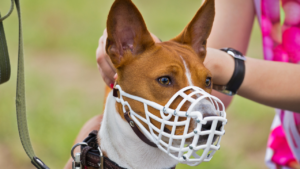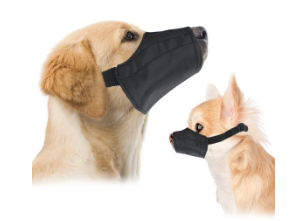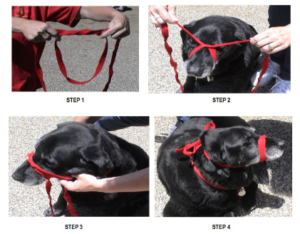Dog muzzles are valuable tools for various situations, but their use requires careful consideration. In this guide, we go over different types of muzzle, training, appropriate times to use dog muzzles and the worst times to avoid.
Types of Muzzles
Dog muzzles serve diverse purposes, from training to emergency situations. Choosing the right type is crucial for both effectiveness and the well-being of your furry friend. Here’s a breakdown of different types of muzzles, along with insights into the best and worst options
- Basket Muzzles: Ideal for extended use, these muzzles allow dogs to pant and drink, making them suitable for walks and vet visits. There are metal and plastic types. We recommend using plastic ones over metal ones.

- Soft or “Sleeve” Muzzles: Designed for temporary use, such as nail trims, these muzzles provide a snug fit without causing discomfort.

- Gauze Muzzles: Emergency restraints for short-term use, these muzzles are handy in unexpected situations.

Choosing the right muzzle depends on your dog’s needs and the intended use. Always prioritize the comfort and safety of your furry companion. Our lead trainer here at Pawhootz, Salem Luethy, recommends using a plastic basket muzzle.
Muzzle Training
Muzzle training is a crucial aspect of responsible dog ownership, providing various benefits beyond addressing aggression concerns. Here’s a concise guide to muzzle training your canine companion: Muzzle training serves to make wearing a muzzle a positive experience for your dog. Approach it as a game that fosters safety and comfort. Here is a video tutorial demonstrating muzzle training:
Muzzle training is an essential skill that ensures the safety and well-being of both your dog and those around them. With patience and positive reinforcement, you can make this training a rewarding experience for your furry friend. Ask your trainer how you could make it a positive and comfortable experience for you and your pup if you still have doubts and uncertainty.
Usage
Muzzles do not necessarily indicate an aggressive dog. They are most associated with aggression, but muzzles are used for friendly dogs for various purposes as well. Associating muzzles solely with aggression contributes to a stigma that can be harmful. They are about safety and comfort for both humans and the dogs wearing them.
Appropriate Times to Use
Vet Visits: Muzzles can prevent bites and ensure the safety of both the dog and the vet during examinations or treatments. It is always good to be honest about your pet and share any concerns and uncertainties with their behavior. If you are not sure how your pet will react in certain situations, still let the vet know. Vets will provide a muzzle if you request one; or recommend one for the duration of their visit. – especially if your dog is displaying defensive or aggressive behavior. Injured dogs are also more prone to react negatively to touch, so they may need a muzzle (unless they are struggling to breathe).
Training Sessions: Muzzles aid in behavioral training, especially for dogs prone to aggression or fear, allowing trainers to work safely. If your dog isn’t muzzle trained, ask your trainer for tips to ensure everyone’s safety.
Grooming: Dogs may feel stressed during grooming sessions, making a muzzle a helpful tool to ensure the safety of both the groomer and the dog. Dogs can be very friendly but have low tolerance/temperament to being touched. Training a dog to be comfortable with touch can help them overcome this reactiveness and fear. Make sure to express any uncertainty to staff to prevent any accidents. Also, consider any injuries your dog may have sustained before grooming.. As mentioned prior, injured dogs are more prone to react.
Preventing Eating Harmful Substances: Muzzles can be used during walks to prevent dogs from eating harmful substances. Some dogs even eat feces – which is a common and normal problem for puppies that usually goes away by adulthood. However, some adult dogs still do this – which may be a sign of behavioral issues. There is also a condition called Pica – where a dog consistently eats objects that are not food items. A muzzle would prevent these dogs with this common condition from ingesting objects.
Worst Times to Use
Punishment: Muzzles should never be used as a form of punishment. It can create negative associations and worsen behavioral issues.
Extended Periods: Prolonged use of muzzles is discouraged as it can cause discomfort and hinder natural behaviors. Use soft or sleeve muzzles for no more than 20 minutes a day. Wear basket muzzles for about an hour at a time throughout the day. Only use gauze muzzles during emergency situations and remove them immediately after the need has passed.
Without Training: Introducing a muzzle without proper training can induce stress and fear in dogs, leading to negative consequences.
In Hot Weather: Muzzles can limit a dog’s ability to pant, which is crucial for cooling. Avoid using muzzles during hot weather to prevent overheating.
Remember, responsible and humane use of muzzles involves proper training, positive reinforcement, and consideration of the dog’s well-being.
Contact Us
Learn more: www.pawhootz.com
Email us: [email protected] or call us at 817-498-6410, too!
Make an appointment with us: https://pawhootz.com/make-an-appointment/



